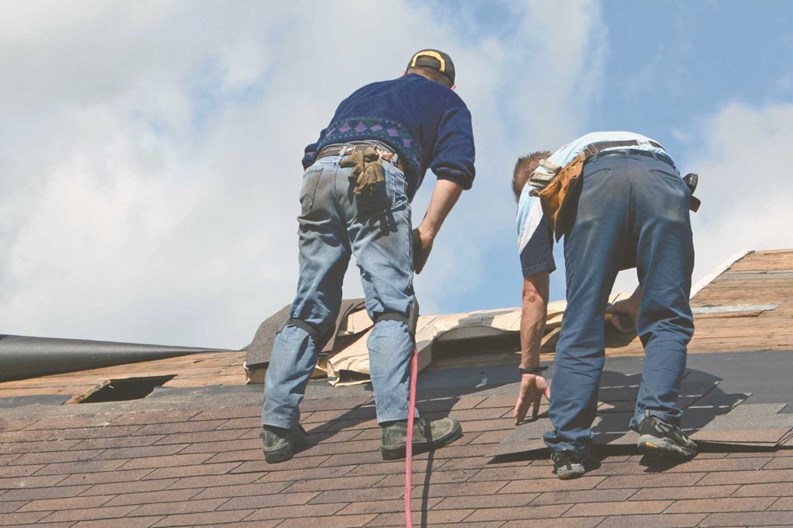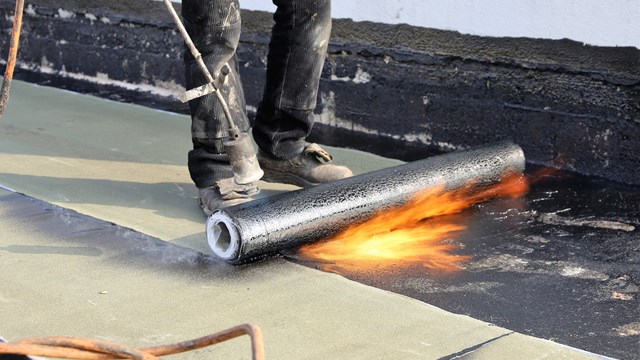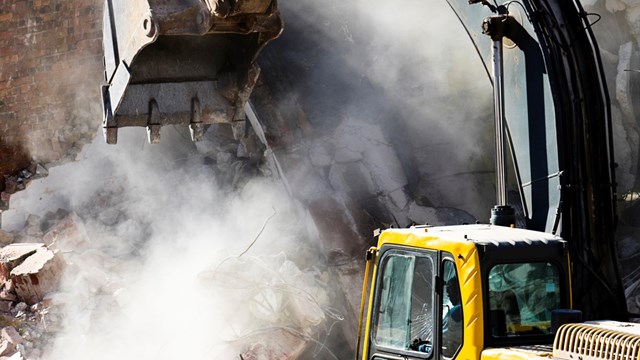You may have a roof over your head—but if that roof isn’t doing its job, you may as well be living on the cold, wet street.
Roofs serve as the first line of defense against whatever the skies throw at your development, so it’s crucial for it to be sound and well maintained—leaky roofs can cost thousands of dollars in water damage, and association boards and management who ignore their roof problems run the risk of legal exposure, should a homeowner’s possessions and property be damaged by leaks or collapses.
The Roof Truth
Before you rebuild, repair or maintain your roof, you’ll need to know what type of roof you’ve got. In a region where space is at a premium, most apartment buildings in central and northern New Jersey sport a flat roof, though according to Mike Keller of George J. Keller & Sons LLC, a roofing contractor based in Flanders, both flat and pitched types are very common.
Space efficiency isn’t the only perk of being peakless. Flat roofs are more accessible for the fire department and for any repairmen. Plus, they’re more easily maintained than shingled, pitched roofs. Flat roofs aren't completely flat, of course—they do have a slight slope to permit water to easily flow into drainage and plumbing openings—but the angle isn’t drastic enough to make it difficult for people to walk on top.
All those advantages doesn't mean that a flat roof can work miracles. They still have their issues. There are three big problems that can affect flat roofs: Expansion and contraction, ultraviolet rays and moisture.
The roof is at its best when it’s brand new. As soon as it’s installed, the flat roof starts to degrade from the lack of expansion and contraction. According to roofing experts, you can even see the degradation—the roof becomes porous and will have tiny cracks and blisters. Investing in the best quality materials whenever you hire a contractor to repair or replace your roof will help with this problem, but even the best-built roofs require TLC and a trained eye to spot small problems before they turn into big (and expensive) ones.
Fending Off Threats
According to Keller, “Depending on material, flat roofs can go anywhere from 15 to 20 years, and pitched can last up to 20 or 30.” Most roof professionals will agree that the biggest threats to the effective life span of a roof is poor initial construction, and/or a lack of regular, competent maintenance.
Lynn Picone, senior project manager for GAF in Wayne, adds that “penetration points are the most vulnerable aspect of any roof system. Proper flashing is imperative to keeping water out. Another aspect that can be particularly difficult for a condo is if there’s not a design break—like a parapet wall, for example—to separate different roof areas. If one section of a roof needs major repair or replacement, it’s often very challenging to marry the new section to an existing area that is not being replaced.”
Poor design, subpar materials, and bad construction are often culprits in roof trouble, says William S. Tipton, a registered roof consultant and the president of Roof Maintenance Systems in Farmingdale. “And in many HOAs, more money is spent on amenities than on a long-term roofing system. The roof is not something that is seen, so it's something that nobody wants to put any money into. Unfortunately, that means that instead of having a 20, or 25-year roof, you get a roof that's 15 years old and has been a problem for the last five years. I'm sure part of it is a cost issue, but I think another part of [poor maintenance] is that it's very hard for boards and associations to get a consensus on anything.”
Penetration is indeed a issue, agrees Fred Fania, president of Fania Roofing in Dover. “In general, whenever a roof is penetrated through or adjoining to, like abutted against, so normally let's say you have a penetration going through a roof like a chimney or a vent pipe or any other mechanical projection through the roof, that's usually gonna be a problem. Anything geometrically that interrupts that plane is trouble, so you got to make sure.”
Another threat to a roof's soundness is the very thing it protects against: the sun. While ultraviolet rays can make a roof age much faster, most roofing professionals say that can actually be mitigated fairly easily. You can curb the negative effects of rays by applying—or having a roof technician apply—an ultraviolet chemical roof coating, which will make the roof reflect the rays instead of absorbing them.
There’s nothing you can do to deflect the moisture, which will be a result of the rain, the snow and even dew. But you need to make sure the roof has a proper pitch so the water never stays long on top of the roof, say the pros. Have a roof specialist check out your roof to make sure the pitch is slanted at the right angle and is doing its job.
Once you make sure your roof is pitched properly, you need to make sure that there’s nothing obstructing the drain. Sounds easy, right? But even snow can be a major problem because it can turn into ice, which in turn can cover drains and cause headaches.
Roofing professionals stress that every time it snows, you need to remove the snow from the roof immediately. If the snow is very heavy, they warn that the drains can become iced, water can melt and penetrate everywhere, and the roof could even collapse.
Here’s the Pitch
A majority of New Jersey’s homeowner associations have pitched or sloped roofs. One of the most important maintenance tasks is keeping the roof components well-maintained, and the gutters free of debris. “Gutter cleaning is probably the simplest thing,” Fania explains. “Most common things are probably keeping debris free and cleaning gutters. But more important if you have someone that's regularly at the site or visits the site, and is employed by the condo association as a manager; they can start to get familiar with the components of what looks right.”
Also be sure that anyone working on your roof, especially if they are an in-house building employee, is covered, he says. “The only thing you have to be really concerned when you get into working on a roof is your insurance coverage. If you have an employee that works for you and you are a condo association, if you're not properly covered for having anyone climbing ladders up on roofs, then you shouldn't. So it's just not a skill-set thing, it's what your coverages are.”
What's Going On Up There?
Part and parcel of keeping your roof sound and watertight is bringing in inspectors who are trained to assess the condition of your building's roof, and who can help your association work out a feasible maintenance and/or repair schedule.
According to Tipton, such an assessment should be done twice a year—in the fall, before the heating season, and again in the spring, after the snow has melted. During an inspection, Tipton says a roofing professional will look for a number of things. “If they're doing it properly, you walk all the components of the roof. Your perimeter detail could consist of three, maybe four components. You could have a flashing, a counter flashing, a parapet wall, and a coping.
“You can't walk that perimeter just one time and look at all those items, looking for openings or deficiency issues. It's not going to happen—you're going to miss something,” Tipton says. “So you have to walk the whole thing, and look where the flashing is. Then you walk it again to get the counter flashing. Then again, checking the parapet for cracks, porosity, different things. You check around the coping cap, then check all your roof penetration. You do all your roof drains, expansion joints, and then you really should walk the entire field of the roof, looking for any kind of problems or issues. That's your best way to do a maintenance inspection. Because it's very easy to miss something, and something you miss in the fall could be a major problem in the spring.”
With a pitched or sloped roof, you might need some visual aid, Fania says. “If it's a slope roof, they might want to invest in a pair of binoculars just to see if something doesn't look right. In most cases it's a lot of common sense.”
While it’s certainly possible—and desirable—for a member of an association’s maintenance staff to periodically take a look at the HOA’s roof surfaces for any glaring problems, roof care shouldn’t be left entirely in the hands of on-site personnel, says Picone. “A staff member can safely inspect, clean a clogged drain, pick up trash, install sealants or caulks or even install a reflective coating,” she says. “But working on a ladder or roof can be dangerous business. A professional roofing contractor is always best suited to perform most roofing repairs.”
Live Long and Prosper.
The good news is that if you properly maintain your roof, the professionals say you can go decades, and possibly even an entire lifetime without having to replace it. The most important part is the maintenance.
Ideally, a serviceman should inspect the roof every time the season changes. Fania recommends at least an annual or semi-annual inspection. He says it depends on how complicated the building is and how well the roof has been maintained..
The serviceman can be a building maintenance person or an official roofing inspector. All they need to do is make sure nothing is amiss and no damage or deterioration has surfaced since the previous inspection. Inspections are typically charged by the hour, according to Fania. “Depending on what kind of backup report you want,” says Fania, “then they'd have to do photos and so on and so forth, it could be anywhere from a simple inspection—anywhere between $250, to more involved—it could be thousands of dollars.”
A roof’s lifespan generally depends on the type of material used and what your expectations are, says Fania. In general, most of the materials on the market today, the most common is probably a 30 to 35-year asphalt shingle on residences. In most cases, 30 years is the norm, he says.
While the basic inspection can be done by anyone in the building, it’s best to leave major roof repairs and installation to the professionals, says Keller. The biggest reason for this is because materials manufacturers generally require that their products be inspected and serviced by a licensed or certified professional, or else any warranty on them may be voided. “You need to recognize and address situations—don't let them fester,” Keller continues. Your building staff can do routine cleaning, and address drains and gutters, but pros should do any replacement or sealing work.”
Once you have the warranty, the roof will usually be guaranteed for 10 to 20 years—but if you try to fix a leaky roof or a cracked board yourself, you may be wreaking more havoc than it’s worth. If the leak is under warranty, and you don’t have a certified roofer to do the repair, it could give them a reason to void the warranty. If you follow the rules and do your inspections and maintain the roof properly, the professionals agree that it should last well beyond its warranty.
“Understand how your roof system is being used,” says Picone. “Look for abuse, repair issues promptly, and be aware that minor issues can turn into leaks if left ignored.” With good installation, proper care, and regular maintenance, your building's roof should keep the rain (and everything else) off your heads for many, many years to come.
Danielle Braff is a freelance writer and reporter living in Chicago. Additional reporting by The New Jersey Cooperator’s David Chiu.







Leave a Comment